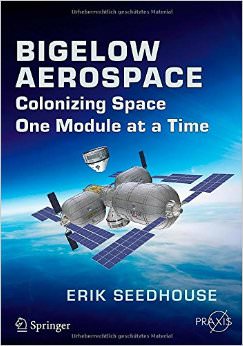You’ve had a busy day wandering around a faraway part of our solar system. It’s time to put your head down for a nap. Where do you place it? According to Erik Seedhouse in his book “Bigelow Aerospace: Colonizing Space One Module at a Time“, you easily slip into a space module, doff your all-purpose space suit and enjoy the pleasures of a safe secure environment. Know of a better way to get over that stressful day?
Now what can you write about a space module? You can try to present all sorts of details and specifications, but that makes for a rather dry read. You can try to present imaginative different uses and configurations, but they’d be only pipe dreams. Or, you can bring both together and add lots of recent history, and you’d come up with something like what Seedhouse provides.
In his book, he shows that while Bigelow Aerospace has something ready for the International Space Station this year, it derives from a NASA concept many years ago. In particular, he sets the direct precursor as NASA’s TransHab that resulted from copious design work and intensive testing. Actually, a good part of the first part of the book is all about the NASA studies; sometimes reading as if the information came direct from NASA technical sheets. The nice thing about this is that the detail is quite involved. For example, are you interested in knowing the relative stress and strain qualities of phenylene benzobisoxazole? Or that early balloons were made of polyethylene terephthalate film? On the imaginative side, the book has many great diagrams and pictures of hypothetical inflatable modules, whether for journeying to Mars, visiting an asteroid or just hanging around in a centrifuge. These serve well to describe the intended usage by NASA as well as the ideas that Bigelow Aerospace is contemplating for the future of space modules.
While the details on space modules fill most of the book, there’s more. The book begins with a slight biography of Robert Bigelow. While these facts are interesting, their only relevance seems to be with Bigelow’s purchase of the eight TransHab rights and with his keen interest and support of many things related to aliens and UFOs. Towards the book’s end, Seedhouse spreads his topic to include a discussion on the launcher industry. Here, he rightfully cautions that the success of private industry space modules comes directly from the success of private industry launchers. And we know how well this is going so far! Seedhouse’s last chapter imagines how a space module can be used on the Moon but then he also warns that other countries, such as China, may claim that world beforehand.
Yes, this book seems to have so much in it and so much going for it. Somehow though, it misses the mark. With a title screaming out ‘Bigelow’, I would have expected lots of corporate insights. Yet, it seems that the author’s sole direct knowledge source is one interview with Robert Bigelow. The book’s data reads almost as if straight from a NASA data sheet or a Bigelow Aerospace advertisement. Yes, this smallish book does have lots in it, but nothing that pushes the boundary forward. Equally the near xenophobic rant toward the end detracts from an otherwise sound technical review. Still, once the Bigelow Expandable Space Module becomes part of the International Space station at least the book’s subject will have made a great step forward.
The technical review is the strength of this book by Erik Seedhouse. In “Bigelow Aerospace – Colonizing Space One Module at a Time” we get the feel for a technology that has showed a lot of promise and is on the verge of becoming a player in space. In many ways, the book is homage to a person that’s taken a waylaid government idea and turned it into a corporate product. As the book implies, go industry, go!
The book is available at Amazon. Find out more about Eric Seedhouse at the Astronauts4Hire website. Learn more about Bigelow Aerospace here.


Did you hear about the man who got cooled to absolute zero? He’s OK now.
🙂
Its kinda odd the author warns about China. AFAIK moonshine realtors have already auctioned off the moon. No leftover crumbs for the Chinese.
How are the orbital tests of the Bigelow modules coming along? Are the two test articles still on orbit and functioning as planned? We must assume they are because NASA is launching another (BEAM) to the ISS aboard the next Dragon flight…